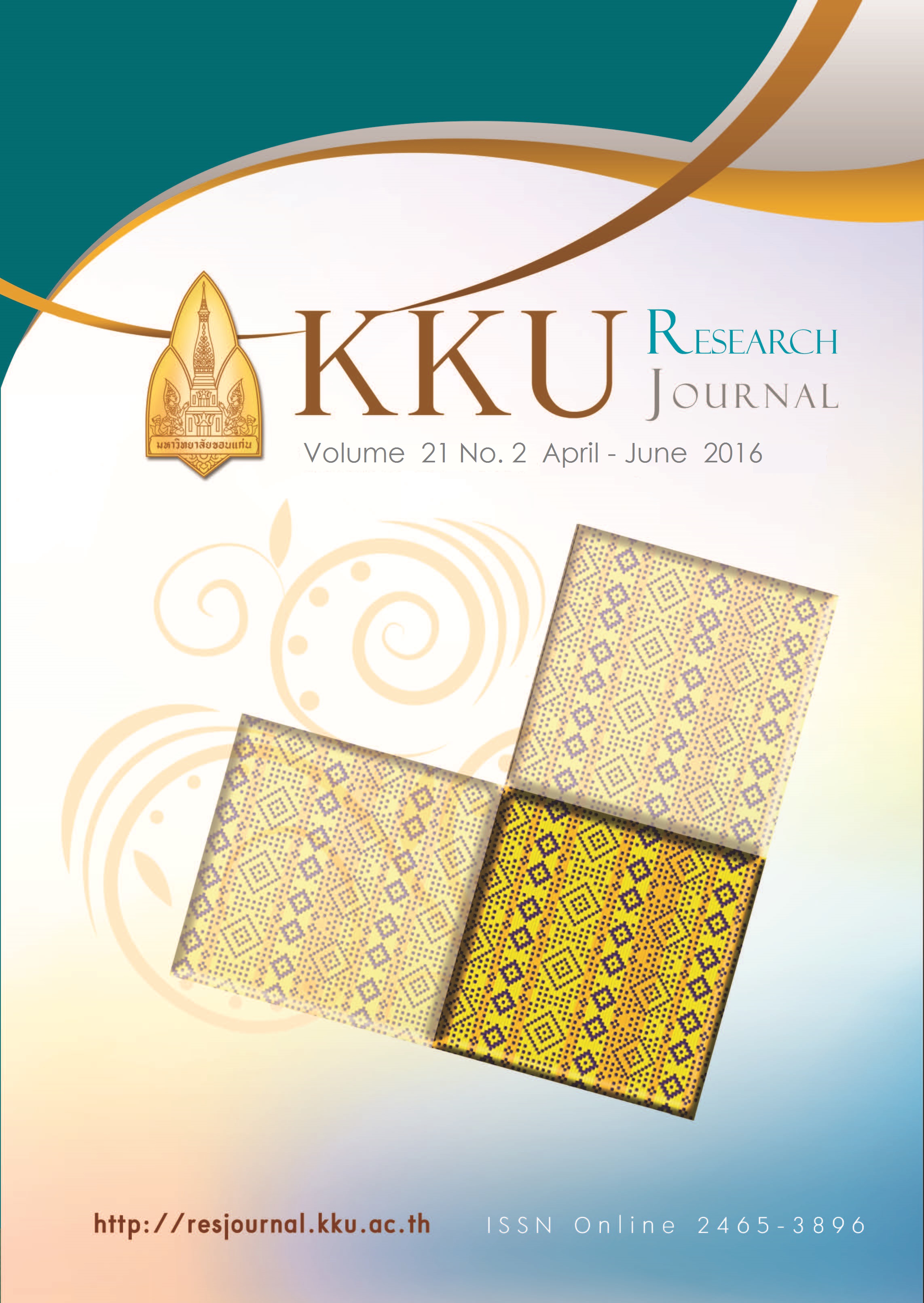Vacuum impregnated rice as affected by moisture contents and rice varieties
Main Article Content
Abstract
Rice is an economical commodity for Thailand. Although it is common to directly consume the rice, its commercial value can be increased through processing, such as vacuum impregnation. Therefore, the aim of this study was to investigate the effect of moisture contents and rice types on the physicochemical properties of vacuum impregnated rice. Four different rice varieties, including white rice (Sao Hai), white glutinous rice (Kiaw Ngu), black rice (Hom Nin) and black glutinous rice (Kum Doi Saket), were cooked in an electric cooker at different water addition to produce cooked rice with moisture contents of approximately 50 or 60%. The cooked rice was then subjected to vacuum impregnation at 50 mbar for 10 min in an impregnation solution of saline solution at a ratio of 1:2 for rice and water, respectively, followed by another 10 min period in the solution as a relaxation time. Physicochemical analyses of the impregnated rice showed that different rice varieties and moisture contents of cooked rice significantly affected hardness, rice volumetric deformation (γ value), volume of rice occupied by impregnation solution (X value), real porosity (εr), solid gain and water loss (p<0.05). The white glutinous rice with a moisture content of 50.71±0.30% significantly had the highest γ and X values of 1.00±0.64 m3/m3 initial sample and 1.15±0.04 m3 liquid/m3 sample, respectively. This rice treatment also significantly possessed the lowest water loss (–94.97±3.06%), whereas the highest solid gain of 2.45±0.16% was determined in the white rice with a moisture content of 49.50±0.55%. For the εr value, the lowest value of this parameter (0.022±0.018%) was found in the black glutinous rice with a moisture content of 50.14±0.22%. Finding from this study clearly suggested rice varieties and moisture contents of cooked rice are important parameters in the application of vacuum impregnation.
Article Details
References
[2] Bhattacharya KR. Rice quality: A guide to rice properties and a n a l y s i s . C a m b r i d g e , U K : Woodhead Publishing Limited; 2011.
[3] Billiris MA, Siebenmorgen TJ, Wang YJ. Rice degree of milling effects on hydration, texture, sensory and energy characteristics Part 2. Cooking using fixed, water-to-rice ratios. J Food Eng. 2012 Jul 14;113:589–97.
[4] Daomukda N, Moongngarm A, Payakapol L, Noisuwan A. Effect o f c o o k i n g m e t h o d s o n physicochemical properties of b r o w n r i c e . I P C B E E 6 2 . Proceedings of the 2nd International Conference on Environmental
Science and Technology; 2011; Singapore; 2011. P. V1-4.
[5] Derossi A, Pilli TD, Severini C. The application of vacuum impregnation techniques in food industry. In: Valdez B, editor. Scientific, health and social aspects of the food industry. Croatia: InTech; 2012. Available from: https://www.intechopen.com/books/scientific-health-and-socialaspects-ofthe-food-industry/theapplication-of-vacuumimpregnation-tech-niques-in-food-industry.
[6] Fito P, Andrés A, Chiralt A, Pardo P. Coupling of hydrodynamic mechanism and deformationrelaxation phenomena during vacuum treatments in solid porous food-liquid systems. J Food Eng. 1996;27(3):229-40.
[7] Guillemin A, Degraeve P, Noëla C, Saurel R. Influence of impregnation solution viscosity and osmolarity on solute uptake during vacuum impregnation of apple cubes (var. Granny Smith). J Food Eng. 2008;86:475–83.
[8] Hironaka K, Kikuchi M, Koaze H, Sato T, Kojima M, Yamamoto K, Yasuda K, Mori M, Tsuda S. Ascorbic acid enrichment of whole potato tuber by vacuumimpregnation. Food Chem. 2011;127:1114-18.
[9] Horigane AK, Suzuki K, Yoshida M. Moisture distribution of soaked rice grains observed by magnetic
r e s o n a n c e i m a g i n g a n d physicochemical properties of cooked rice grains. J Cereal Sci. 2013;57:47-55.
[10] Krasaekoopt W, Suthanwong B. Vacuum impregnation of probiotics in fruit pieces and their survival during refrigerated storage. Kasetsart J. (Nat. Sci.). 2008 Jun 23;42(4):723-31.
[11] Lu S, Cik T, Lii C, Lai P, Chen H. Effect of amylose content on structure, texture and α-amylase reactivity of cooked rice. LW T- F o o d S c i Te c h n o l . 2013;54:224-28.
[12] Luangmalawat P, Prachayawarakorn S, Nathakaranakule A, Soponronnarit S. Effect of temperature on drying characteristics and quality of cooked rice. LWT-Food Sci Technol. 2008;41:716-23.
[13] M e e - n g e r n B , L e e S J , Choachamnan J, Boonsupthip W. Penetration of juice into rice through vacuum drying. LWT-Food Sci Technol. 2014;57:640-47.
[14] Noorbakhsh R, Yaghmaee P, Durance T. Radiant energy under vacuum (REV) technology: A novel approach for producing probiotic enriched apple snacks. J Funct Foods. 2013;5:1049-56.
[15] Piromvard O, Thepmongkhon J, Yuenyongputtakal W. Production of probiotic-enriched dragon fruit (Hylocereus undatus) under vacuum impregnation. Agricultural Sci. J. 2010 Sep;41(3/1) (Suppl.):233-36.
[16] Rewthong O, Soponronnarit S, Taechapairoj C, Tungtrakul P, Prachayawarakorn S. Effect of cooking, drying and pretreatment method on texture and starch digestibility of instant rice. J Food Eng. 2011;103:258-64.
[17] Rongkom H, Phianmongkhol A, Wirjantoro TI. Physical properties of impregnated cantaloupe and apple affected by different pressure levels. Asian J Agric Food Sci. 2013 Oct 04;1(4):1163-71.
[18] Sompong R, Siebenhandl-Ehn S, Linsberger-Martin G, Berghofer E. Physicochemical and antioxidative properties of red and black rice varieties from Thailand, China and S r i L a n k a . F o o d C h e m . 2011;124:132-40.
[19] Song BS, Park JN, Lee JW, Kim JK, Kim JH. Optimization of processing conditions to improve the rehydration and sensory properties of freeze-dried cooked rice. J Food Process a n d P r e s . 2013;38:1244–50.
[20] Yan Z, Sousa-Gallagher MJ, Oliveira FAR. Shrinkage and porosity of banana, pineapple and mango slices during air-drying. J Food Eng. 2008;84:430–40.

